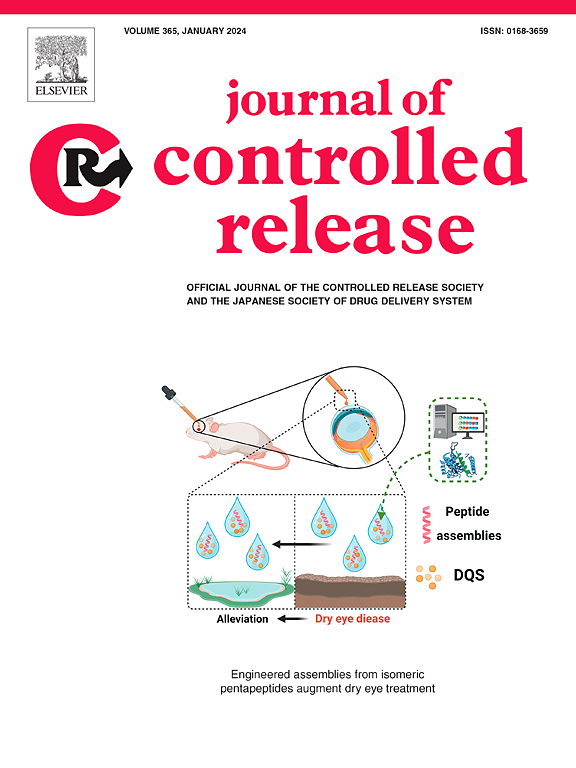合理设计刺激反应纳米粒子系统,用于控制免疫治疗和化疗药物的细胞内递送
IF 10.5
1区 医学
Q1 CHEMISTRY, MULTIDISCIPLINARY
引用次数: 0
摘要
由于对癌细胞生物学和复杂的肿瘤微环境有了更好的基本了解,先进的癌症治疗策略正在迅速发展。因此,需要更好地合理设计生物反应性纳米治疗药物,以便从肿瘤微环境中获取线索,更好地促进多种癌症治疗药物的细胞内递送。生物可降解的阳离子纳米凝胶是通过紫外线引发的自由基乳液聚合合成的,为免疫治疗和化疗药物的细胞内递送提供了环境响应行为。2-(二乙胺)甲基丙烯酸乙酯基共聚纳米凝胶对肿瘤微环境和癌细胞内体区室的pH梯度进行了优化,显示出pH响应行为。然后,评估阳离子纳米凝胶装载和释放各种化疗和免疫治疗剂的能力。最后,对共聚纳米颗粒体系进行了体外生物相容性、细胞内化和治疗效果的评估。这种联合治疗策略将为下一代给药系统的合理设计和开发提供良好的基础。本文章由计算机程序翻译,如有差异,请以英文原文为准。

Rational design of stimuli responsive nanoparticle systems for the controlled, intracellular delivery of immunotherapeutic and chemotherapeutic agents
Advanced cancer therapeutic strategies are rapidly evolving due to a better fundamental understanding of cancer cell biology and the complex tumor microenvironment. There is a need for better rational design of bioresponsive nanotherapeutics to take cues from the tumor microenvironment and better facilitate the intracellular delivery of multiple cancer therapeutic agents. Biodegradable, cationic nanogels were synthesized via a UV-initiated free radical emulsion polymerization to impart environmentally responsive behavior for the intracellular delivery of immunotherapeutic and chemotherapeutic agents. The 2-(diethylamino) ethyl methacrylate based copolymeric nanogels exhibited pH responsive behavior that was optimized for the pH gradient of the tumor microenvironment and endosomal compartments of cancer cells. Then, the cationic nanogels were assessed for their ability to load and release various chemotherapeutic and immunotherapeutic agents. Finally, the copolymeric nanoparticle system was evaluated in vitro for biocompatibility, cellular internalization, and therapeutic efficacy. This combination treatment strategy will provide an excellent foundation for the rational design and development of the next generation of drug delivery systems.
求助全文
通过发布文献求助,成功后即可免费获取论文全文。
去求助
来源期刊

Journal of Controlled Release
医学-化学综合
CiteScore
18.50
自引率
5.60%
发文量
700
审稿时长
39 days
期刊介绍:
The Journal of Controlled Release (JCR) proudly serves as the Official Journal of the Controlled Release Society and the Japan Society of Drug Delivery System.
Dedicated to the broad field of delivery science and technology, JCR publishes high-quality research articles covering drug delivery systems and all facets of formulations. This includes the physicochemical and biological properties of drugs, design and characterization of dosage forms, release mechanisms, in vivo testing, and formulation research and development across pharmaceutical, diagnostic, agricultural, environmental, cosmetic, and food industries.
Priority is given to manuscripts that contribute to the fundamental understanding of principles or demonstrate the advantages of novel technologies in terms of safety and efficacy over current clinical standards. JCR strives to be a leading platform for advancements in delivery science and technology.
 求助内容:
求助内容: 应助结果提醒方式:
应助结果提醒方式:


